The Peripheral Embolization Device Market is estimated to be valued at USD 696.5 million in 2025 and is projected to reach USD 1370.0 million by 2035, registering a compound annual growth rate (CAGR) of 7.0% over the forecast period.
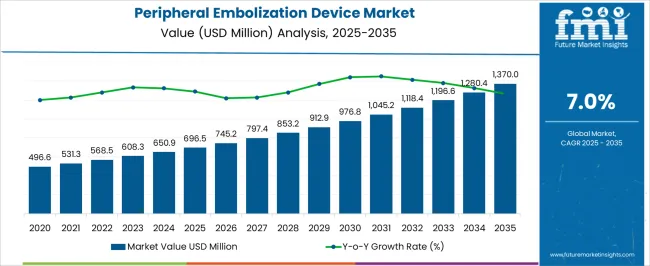
| Metric | Value |
|---|---|
| Peripheral Embolization Device Market Estimated Value in (2025 E) | USD 696.5 million |
| Peripheral Embolization Device Market Forecast Value in (2035 F) | USD 1370.0 million |
| Forecast CAGR (2025 to 2035) | 7.0% |
The peripheral embolization device market is witnessing consistent growth, driven by the rising prevalence of vascular diseases and the growing adoption of minimally invasive procedures. Increasing incidence of conditions such as aneurysms, arteriovenous malformations, and peripheral vascular malformations is creating sustained demand for embolization therapies. Advancements in device design, including improved biocompatibility, controlled delivery systems, and enhanced precision in targeting abnormal blood flow, are strengthening the clinical outcomes associated with these procedures.
The market is also benefiting from expanding healthcare infrastructure, particularly in emerging economies, where interventional radiology and endovascular treatments are gaining momentum. Favorable reimbursement frameworks in developed regions are accelerating the adoption of these devices across hospitals and specialized clinics.
Additionally, technological innovations in embolic materials and catheter-based delivery platforms are broadening the scope of indications treated with embolization With a growing emphasis on minimally invasive approaches that reduce recovery times and hospital stays, the peripheral embolization device market is positioned for sustained expansion, supported by rising clinical acceptance and ongoing product innovation.
The peripheral embolization device market is segmented by product type, end user, and geographic regions. By product type, peripheral embolization device market is divided into Platinum Coils, Embolization Guidewires, Microcatheters, Occlusion Systems, and Occlusion Balloons. In terms of end user, peripheral embolization device market is classified into Hospitals, Ambulatory surgical centers, and Specialty clinics. Regionally, the peripheral embolization device industry is classified into North America, Latin America, Western Europe, Eastern Europe, Balkan & Baltic Countries, Russia & Belarus, Central Asia, East Asia, South Asia & Pacific, and the Middle East & Africa.
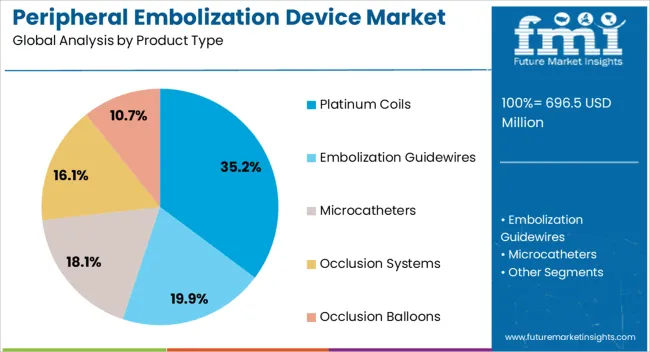
The platinum coils segment is projected to hold 35.2% of the peripheral embolization device market revenue share in 2025, establishing itself as the leading product type. This dominance is being driven by the unique properties of platinum, including high radiopacity, flexibility, and biocompatibility, which allow clinicians to achieve precise placement and durable occlusion of abnormal vessels.
Platinum coils are widely preferred due to their ability to provide reliable visualization during procedures, thereby improving procedural accuracy and patient safety. The segment is further supported by continuous design improvements, such as detachable coil systems and advanced delivery mechanisms, which enhance physician control and procedural outcomes.
Increasing use in treating aneurysms and peripheral vascular conditions has reinforced their clinical relevance, particularly in complex cases where durability and precision are critical With rising adoption of minimally invasive endovascular interventions and expanding application in diverse vascular indications, platinum coils are expected to maintain their leadership, benefiting from strong physician preference and ongoing technological refinements.
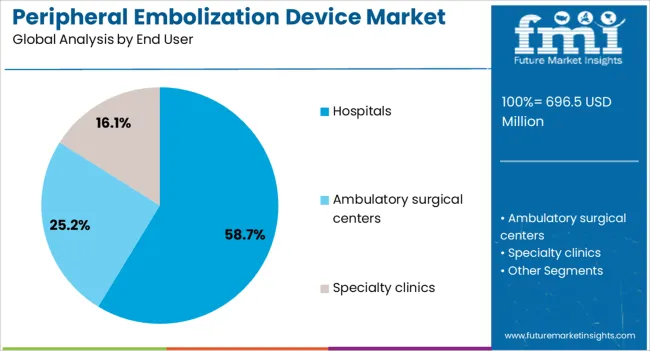
The hospitals segment is anticipated to account for 58.7% of the peripheral embolization device market revenue share in 2025, making it the dominant end user. This leadership is being driven by the availability of advanced interventional radiology units, skilled medical professionals, and comprehensive infrastructure required to perform complex embolization procedures. Hospitals are often the first point of care for patients with vascular disorders, ensuring higher procedure volumes compared to other end users.
The presence of multidisciplinary teams, including vascular surgeons, interventional radiologists, and neurologists, enhances the ability of hospitals to deliver specialized embolization treatments effectively. Favorable reimbursement policies and continuous investments in upgrading hospital infrastructure are further strengthening this segment.
Additionally, hospitals are increasingly adopting cutting-edge technologies such as image-guided navigation systems and hybrid operating rooms, which improve procedural efficiency and patient outcomes As the burden of vascular diseases rises globally and patient preference shifts toward institutions offering advanced care, hospitals are expected to remain the leading setting for peripheral embolization procedures.
Embolization is a process through which embolus is placed into the blood vessel to block the blood flow to a particular area of the body. The embolus is usually a blood clot formed due to clotting of blood cells.
However, the artificial embolus is used to close off blood vessels to prevent the blood from reaching a particular part of the body to eliminate abnormal conditions in the body like a renal aneurysm, arteriovenous fistula, hypogastric artery embolization, endoleak embolization, GI bleeding and treatment of tumors.
Peripheral embolization is usually used to shrink tumors by blocking the blood flow to it. Peripheral embolization devices often use embolus made up of various drugs which along with blocking the blood flow also are targeted towards the treatment of a tumor. Embolization is efficient and less invasive as compared to open surgery and therefore poses a little risk to the patient.
The global peripheral embolization device market is driven by the rising incidence of cancer and cardiovascular diseases. According to CDC (Centers for Disease Control and Prevention) by 2025, 19.3 million cases of cancer cases are expected to be diagnosed each year, which in turn is expected to increase demand for peripheral embolization devices for early treatment of malignant tumors.
The increasing mortality rate due to cardiovascular diseases is expected to boost demand for peripheral embolization devices. Increasing cardiovascular patients owing rising global geriatric population is expected to provide high growth opportunities for the peripheral embolization devices manufacturers over the forecast period.
Moreover, technological developments in new peripheral embolization devices aimed to increase safety among patients and ease of use for physicians is expected to provide significant growth opportunities for the peripheral embolization devices manufacturers.
However, the high cost of peripheral embolization devices and complications like coil migration, perforations, and spasms among patients is expected to hamper market growth over the forecast period.
The peripheral embolization device market is expected to witness healthy growth throughout the forecast period with North America expected to be the leading market. High demand for peripheral embolization devices from cancer patients is expected to boost the market growth over the forecast period.
Favorable reimbursement policies and up gradation in the compensation for the patients is North America is projected to drive demand for peripheral embolization devices in North America over the forecast period. Moreover, several global manufacturers in this region are expected to promote the use of peripheral embolization devices and in turn is supposed to increase the adoption rate of the devices.
Western Europe is expected to be second largest market followed by North America owing to high awareness related to the use of peripheral embolization devices for treatment of cardiovascular and bleeding disorders. APEJ (Asia-Pacific excluding Japan) and Japan are expected to follow next after Western Europe owing to high population and increasing the incidence of cardiovascular diseases in these regions along with growing per capita healthcare expenditure in countries like India and China.
Eastern Europe and the Middle East and Africa (MEA) is expected to increase significantly owing to the rise in cancer incidence rate and manufacturers focusing on expansion strategies in this regions.
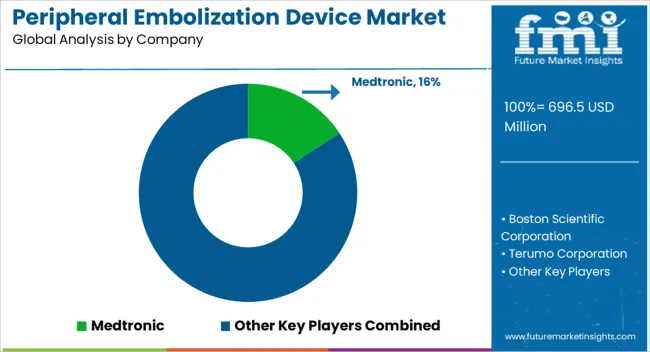
Some key players in peripheral embolization market are Boston Scientific Corporation, Medtronic, Inc., Cook Medical, St. Jude Medical, Inc., Penumbra, Inc., Metactive Medical, Inc., Terumo Corporation and others. The companies are focused on development of new peripheral embolization devices with increased safety and ease of use.
The research report presents a comprehensive assessment of the market and contains thoughtful insights, facts, historical data, and statistically supported and industry-validated market data. It also contains projections using a suitable set of assumptions and methodologies. The research report provides analysis and information according to categories such as market segments, geographies, types, technology and applications.
The report is a compilation of first-hand information, qualitative and quantitative assessment by industry analysts, inputs from industry experts and industry participants across the value chain.
The report provides in-depth analysis of parent market trends, macro-economic indicators and governing factors along with market attractiveness as per segments. The report also maps the qualitative impact of various market factors on market segments and geographies.
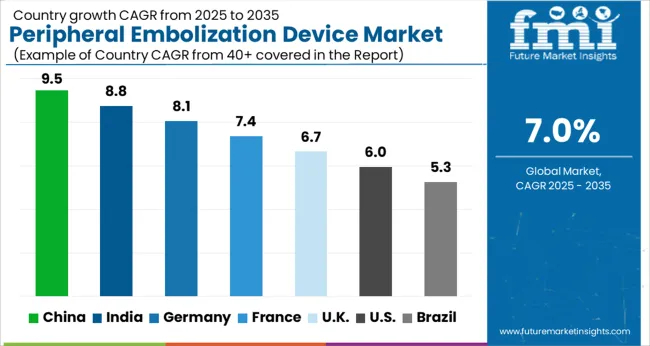
| Country | CAGR |
|---|---|
| China | 9.5% |
| India | 8.8% |
| Germany | 8.1% |
| France | 7.4% |
| UK | 6.7% |
| USA | 6.0% |
| Brazil | 5.3% |
The Peripheral Embolization Device Market is expected to register a CAGR of 7.0% during the forecast period, exhibiting varied country level momentum. China leads with the highest CAGR of 9.5%, followed by India at 8.8%. Developed markets such as Germany, France, and the UK continue to expand steadily, while the USA is likely to grow at consistent rates. Brazil posts the lowest CAGR at 5.3%, yet still underscores a broadly positive trajectory for the global Peripheral Embolization Device Market. In 2024, Germany held a dominant revenue in the Western Europe market and is expected to grow with a CAGR of 8.1%. The USA Peripheral Embolization Device Market is estimated to be valued at USD 243.2 million in 2025 and is anticipated to reach a valuation of USD 433.5 million by 2035. Sales are projected to rise at a CAGR of 6.0% over the forecast period between 2025 and 2035. While Japan and South Korea markets are estimated to be valued at USD 33.6 million and USD 23.8 million respectively in 2025.
| Item | Value |
|---|---|
| Quantitative Units | USD 696.5 Million |
| Product Type | Platinum Coils, Embolization Guidewires, Microcatheters, Occlusion Systems, and Occlusion Balloons |
| End User | Hospitals, Ambulatory surgical centers, and Specialty clinics |
| Regions Covered | North America, Europe, Asia-Pacific, Latin America, Middle East & Africa |
| Country Covered | United States, Canada, Germany, France, United Kingdom, China, Japan, India, Brazil, South Africa |
| Key Companies Profiled | Medtronic, Boston Scientific Corporation, Terumo Corporation, Stryker Corporation, Johnson & Johnson (DePuy Synthes), Abbott Laboratories, Cook Medical, Penumbra, Inc., Merit Medical Systems, Inc., and Sirtex Medical Limited |
The global peripheral embolization device market is estimated to be valued at USD 696.5 million in 2025.
The market size for the peripheral embolization device market is projected to reach USD 1,370.0 million by 2035.
The peripheral embolization device market is expected to grow at a 7.0% CAGR between 2025 and 2035.
The key product types in peripheral embolization device market are platinum coils, embolization guidewires, microcatheters, occlusion systems and occlusion balloons.
In terms of end user, hospitals segment to command 58.7% share in the peripheral embolization device market in 2025.
Explore Similar Insights

Thank you!
You will receive an email from our Business Development Manager. Please be sure to check your SPAM/JUNK folder too.
Chat With
MaRIA